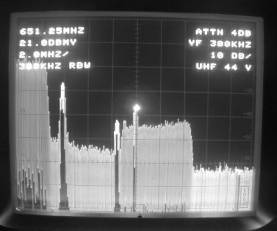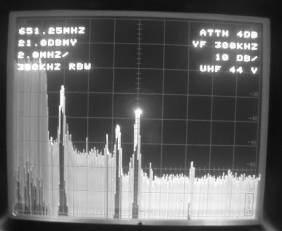THE BIRO TECHNICAL BULLETINS
NOVEMBER 2002
DIGITAL TV
SIGNAL SURVEYS
(A prerequisite for delivering high quality
HDTV pictures)
As of November 1. 2002 more than
530 DTV stations are on-the-air, roughly one in three commercial and educational
analog TV stations in America. For at
least the next four years, TV stations will operate their analog and digital
transmitters simultaneously, creating a tremendous “traffic jam” on-the-air.
Theoretical reception studies,
making limited DTV reception predictions under ideal conditions, are available
from antenna manufacturers and suppliers. Biro
Engineering boasts same day computer-aided and developed
DTV reception studies as well as professional on-site DTV signal surveys.
There is a big difference between
these two engineering services. The
computer-aided DTV reception study is fast and inexpensive, but limited in information.
On the other hand an expertly conducted on-site DTV survey can verify the presence
or absence of interference, as well as signal levels not based on speculation
but real values received by the test antenna. The DTV signal survey can also verify that several
desired analog and digital stations
can be received with the same antenna, reducing cost of the equipment and wind
load on the tower.
Frequently encountered DTV reception
difficulties:
- New
DTV stations may generate excess noise in the pictures of currently
carried analog programs.
- In turn, analog TV stations may
produce co-channel or adjacent channel interference on
HDTV channels. Subscribers,
who spent $5,000 or more on new HDTV receivers can be very unhappy when those
perfect pictures fill up with beats or become fuzzy.
- In certain metropolitan areas, like
Washington/Baltimore or New York/Philadelphia, poorly assigned new DTV channels
can create serious adjacent channel interference problems.
Four case studies are presented below, illustrating the unmatched benefits
of the On-Site DTV signal survey.
CASE STUDY #1:
THE RECEPTION OF A DIGITAL STATION AFFECTED
BY ANALOG
CO-CHANNEL INTERFERENCE
During a Reading, Pa. Digital Signal Survey, the reception of Channel 44,
a digital station from Camden, N.J., was disturbed by the analog Channel 44,
Scranton, Pa.
Observe the test results on the left side photograph. The undesired
Channel 44 analog video carrier exceeded the amplitude of the DTV spectrum.
Thanks to the cooperation of the DTV station, their transmission turned
off for a minute, the Channel 44 video carrier was positively identified. (See the right-side photograph).
Exact Channel 44 directions and distances are displayed on the
computer generated signal direction sheet below.
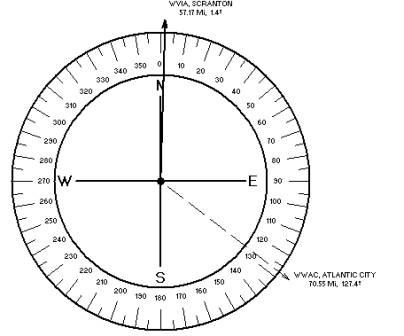
A quad-array of high-gain Channel 44 Yagis was recommended,
with H = 33 ˝” horizontal spacing, to force a deep radiation pattern null
into the direction of the undesired carrier.
CASE STUDY #2:
LOCAL DTV STATION INTERFERS WITH THE RECEPTION
OF A DISTANT DTV STATION.
A DTV survey performed at the Trenton, N.J. head-end
discovered that the reception of DTV Channel 44 is seriously affected by the
adjacent local Channel 43 DTV transmitter.

The photograph above shows that the undesired Channel
43 spectrum’s amplitude was found 20 dB higher than the desired Channel 44.
The computer developed signal direction sheet below
confirmed the proximity of Channel 43, Trenton, displaying exact directions
and distances.

The carriage of Channel 44 was not recommended.
No phased-array could guarantee a 35 dB reduction of the undesired
carrier.
CASE STUDY #3:
DIGITAL STATION GENERATING EXCESS NOISE INTO
THE ADJACENT ANALOG CHANNELS
In Warrensburg, Mo. the on-site DTV signal survey
has proven that Channel 18, a DTV station from Kansas City, generated the
excess noise observed on analog channels, Channel 17 and Channel 19. Observe the photograph below, the total Channel
18 spectrum matching the amplitude of the Channel 17 video carrier.
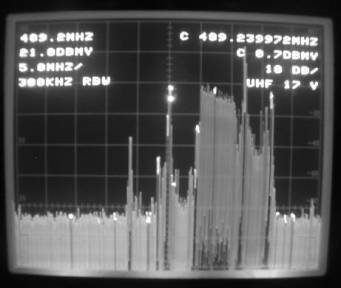
Exact, computer generated directions and distances on the
signal direction sheet below indicated that the adjacent channel interference
can be eliminated with a properly designed phased array.
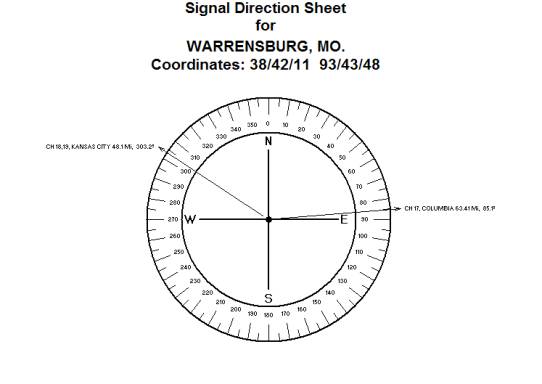
CASE STUDY #4:
SINGLE UHF ANTENNA TO DELIVER FIVE
ANALOG AND DIGITAL STATIONS
At the Springbrook, Md. signal survey the UHF test antenna delivered
the following stations with high signal levels from Baltimore, a short distance
of 26 miles:
| CHANNEL 24 |
WUTB |
ANALOG |
20.26 Mi |
| CHANNEL 38 |
WJZ |
DIGITAL |
26.56 Mi |
| CHANNEL 41 |
WUTB |
DIGITAL |
20.26 Mi |
| CHANNEL 45 |
WBFF |
ANALOG |
26.61 Mi |
| CHANNEL 46 |
WBFF |
DIGITAL |
26.61 Mi |
| CHANNEL 52 |
WMAR |
DIGITAL |
26.50 Mi |
| CHANNEL 59 |
WBAL |
DIGITAL |
26.50 Mi |
| CHANNEL 67 |
WMPB |
ANALOG |
29.74 Mi |
Originally,
all eight (8) analog and DTV stations were to be received by a single eight-foot
parabolic antenna. After developing
the Signal Direction Sheet, the single receiving antenna concept was shelved. The Signal Direction Sheet below clearly shows
that not all stations are received from the same direction.
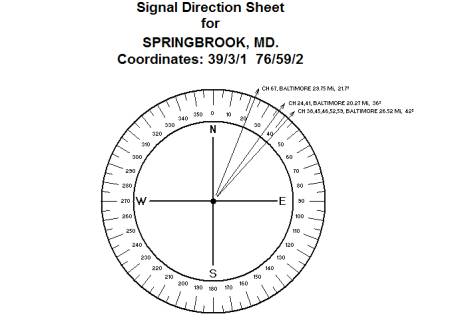
An
8’ diameter parabolic was designated to receive five (5) UHF stations.
A 6’
diameter parabolic was designated to receive two
(2) UHF stations.
A 4’
diameter parabolic was designated to receive one
(1) UHF station.
CONCLUSION
530
DTV stations broadcast HDTV pictures. In
theory, we have a simple paradigm: they transmit, we receive them, end of story. Reality is never so simple. There are many pitfalls.
An
on-site DTV signal survey may prevent costly antenna tower relocations, stripping
the tower and installing new antenna-arrays, as well as service outages.
A professionally conducted DTV signal survey may become one of your best
investments in the age of High Definition Television.
For emergency engineering services:
Call: (609) 883-9866
E-mail: steven@biroengineering.com
Web site: www.biroengineering.com
Biro Engineering
P.O.BOX 2175
PRINCETON, N.J. 08543
